Are you going travelling and in need of the best travel telescope?
Few experiences are more tranquil than watching the night sky through a telescope.
You don’t need an expertise that rivals that of Edwin Hubble to enjoy stargazing; just peering through the lens will give you an insight into how large the universe really is and help put any irritations that you may be experiencing into perspective, as well as helping you connect with nature.
Contents
It’s also a hugely romantic pastime to share with your partner, or a fantastic way of engaging in mindfulness if you’re looking for some quiet time by yourself for idle contemplation.
This guide will talk you through some of the best ways of enjoying a view of the moon and stars whilst on the move.
Celestron PowerSeeker 70EQ
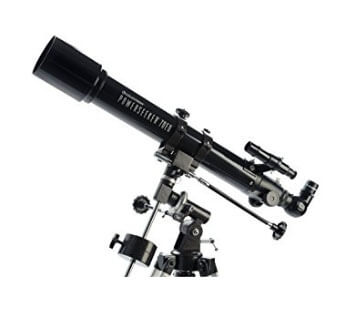
One of the heavier models in the travel scope range, the PowerSeeker weighs in at 14lbs but acts as a wonderful introduction to the world of astronomy.
Easy to assemble straight out of the box with no tools required, all ages can enjoy the use of this scope; it comes packaged with a lightweight aluminum tripod and several lenses, with extra strong additions available separately – before long, you’ll be able to spot almost any planet in the solar system, and even sync your scope up with an official app for your smartphone.
If you are a beginner to world of stargazing and are looking for a strong and simple introduction, you cannot go far wrong with this model, provided the size and weight of the telescope are not an issue for you.
PROS – This telescope is easily constructed straight from the box with no need for tools or complicated instructions – you’ll be able to take the delivery and be staring at the dark side of the moon in no time at all. The ability to sync it up with a smartphone app will also greatly enhance the educational element.
CONS – It’s still comparatively mobile, but the PowerSeeker is not as travel-friendly as some of the scopes on this list. It’s fine for one-off maneuvering to a park, for example, but not ideal for an RV holiday where it will need to be set up in a number of different locations.
Celestron 21035
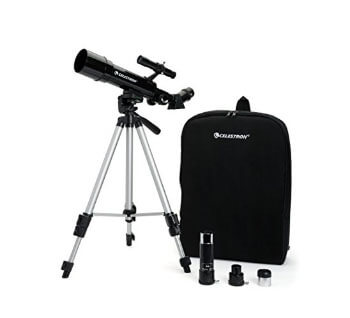
If the idea of the PowerSeeker appeals but is a little too bulky for your requirements, investigate this model from the same manufacturers.
Available at two price points, with a 50mm lens or a slightly more expensive but visually superior 70mm alternative, the Celestron 21035 still requires no tools to fix up but weighs just six pounds and can be transported within the backpack contained in the package, alongside a tripod.
Small in stature but hugely powerful, the Celestron 21035 will magnify sights up to twenty times. The 70mm lens model is also packaged with software that boasts a 10,000-object database, printable sky maps and 75 enhanced images, making it well worth the extra few dollars if you are a novice stargazer.
This larger lens is still one of the most cost-effective models available, meaning that if it breaks on your travels you will not be too heavily out of pocket.
PROS – Easily transported thanks to the backpack provided, deceptively powerful in terms of magnification, and packaged with database software – all at a very appealing price point – this is the perfect telescope for beginners or young people.
CONS – As you may expect for such a cost-effective model, this isn’t the sturdiest scope on the market; the tripod, in particular, may require replacing before too long. The power of the lens may also disappoint seasoned stargazers, as the Celestron 21035 is designed for terrestrial viewing, not celestial.
Orion 10034 GoScope
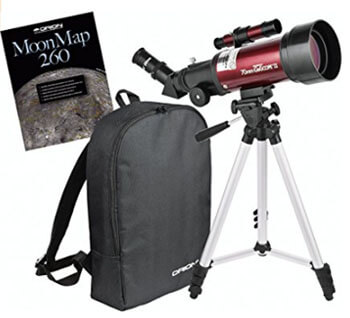
Perfect for families with young children who are keen to stare at the moon while on the go, the Orion 10034 GoScope is a solid but lightweight, aesthetically pleasing travel telescope.
Weighing just 3.5lbs and bundled with a (child-sized) tripod, carry backpack and a moon map book to help guide you in where you point the lens, this is the perfect way to introduce yourself to the realm of the night sky.
It may be advisable to invest in some stronger lenses as you might struggle to capture the real details of other planets using those included with the basic model which magnify to the powers of 16 and 40, but this telescope also doubles up for wildlife-spotting during daylight hours – perfect for safari parks, or even music festivals where the band are further away than you may like.
If you are looking to encourage your children to take up an interest in astronomy, the Orion 10034 GoScope will do the trick.
PROS – Arguably the perfect telescope for young aspiring astronomers, the Orion 10034 is solid, transferable and cost-effective, as well as offering a good view of the moon and stars. The lens is also potent for daytime use, so if taken on holiday you’ll be able to indulge in bird watching and long-distance sightseeing.
CONS – You’ll notice that we’ve mentioned that this telescope is perfect for children on a number of occasions, which is true. Alas, the size means that older people – or even taller children – may struggle to use the tripod provided without hunching over and hurting their back, necessitating the purchase of a new accessory.
Orion 10013 GoScope 80mm TableTop Refractor Telescope
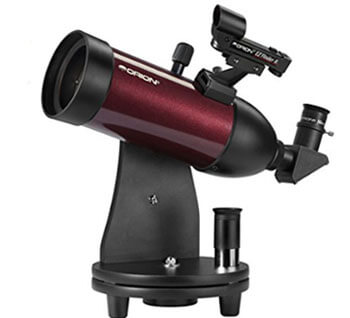
A tabletop version of the telescope above, the Orion 10013 GoScope is a little costlier but even more portable.
This fascinating little unit is the size of a microscope, but it can be mounted onto a tripod if that’s your preference – which is advisable if you’re taller than average.
This tabletop scope offers fantastic capture of light and magnification of up to 35 times out of the box, offering effortless views of all kinds of constellations and far-off planets such as Jupiter and the rings of Saturn.
Best of all, this task is made even easier thanks to the inclusion of a red-light laser pointer, which you can use to direct your search and pinpoint breathtaking views throughout the night sky.
Sit and enjoy your late night coffee by the campfire and marvel at the universe!
PROS – Hugely lightweight and portable, with fantastic potential for spotting stars and planets, there’s a lot to love about this model. The addition of the laser pointer is also a lovely touch that will help newcomers to the art find their bearings.
CONS – Very few – this is a fine piece of kit for the price point. Obviously it is not as powerful as larger, more expensive models, but provided you manage your expectations accordingly you’ll struggle to find a reason to complain.
Orion 10014 SkyQuest XT4.5 Classic Dobsonian Telescope
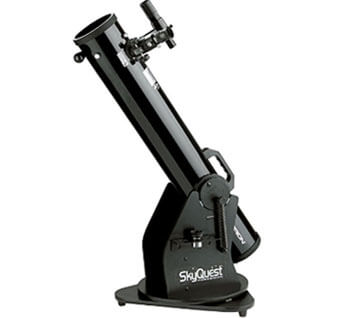
Another Orion model, and another step up from the previous model that we profiled – both in terms of performance and price point, as this is by far the most costly model on our list.
You’ll be getting plenty of extra bang for your buck here though, as the SkyQuest combines all of the wonders of a full-size telescope with the convenience of a tabletop model size.
You’ll experience an absolute minimum magnification of 17 times with this model, ensuring that a beginner’s mind will be blown (especially when they utilize the complementary educational software bundled with the scope), but experienced stargazers may also find this a step up from their existing equipment – professional astronomers have been known to purchase the SkyQuest thanks to the perfect harmony of superior performance and tiny size.
If you’re seeking a balance of performance and maneuverability, look no further.
PROS – Right from the unpacking this telescope from the box you’ll be able to see all kinds of wonderful sights. This is an ideal blend of magnification that rivals a full-size scope and the minimalism that stems from its tabletop dimensions, and the addition of educational software is also a welcome bonus for anybody just beginning their astronomy adventure.
CONS – A price exceeding some of the other equipment may put off novices and beginners (though it’s safe to say that, in the case of the SkyQuest, you get what you pay for), while experienced stargazers may rather pay a little more for a full-sized model and even greater viewing possibilities.
Buyer’s Guide to Travel Telescopes
The size and maneuverability of telescopes vary according to make and model, but as a rule they are generally weighty pieces of kit that need to be anchored into a solitary position.
Indeed, the largest telescope in the world at the time of writing measures in excess of thirty feet, located in the Canary Islands of Spain.
If you are hoping to engage in a little star spotting while on the move, however, travel telescopes are readily available.
What portable telescope is best for you depends on a number of different factors.
You’ll need to some appropriate research to ensure that you are not sacrificing the magnification power in favor of a lightweight design, and prices can fluctuate wildly, but with a little shopping around you should be able to find a travel telescope that meets all of your needs.
I hope you found our summary of five of the best travel telescopes and equipment helpful! These all can be easily sourced online, all of which vary in price point, but are still pretty economical to purchase.
